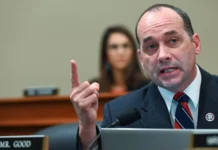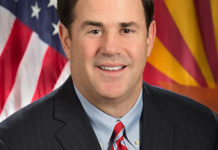
Three Banner Health hospitals are operating above capacity as Arizona confronts a surge in coronavirus cases, the top doctor for the state’s largest hospital chain said Wednesday.
Banner’s Desert, Thunderbird and University hospitals in the Phoenix area have more patients than they’re typically licensed to handle, said Dr. Marjorie Bessel, chief clinical officer. Systemwide, Banner’s intensive care units are at 160% of their typical winter peak, she said, and nearly six in 10 ICU patients have COVID-19. Non-emergency procedures, such as cancer surgeries and hip replacements, have been canceled at some hospitals to keep beds open for patients battling the coronavirus.
All Arizona hospitals have added beds and staff beyond their normal licensed capacity under an executive order signed earlier this year by Gov. Doug Ducey. To treat more people, they’re putting two people in rooms intended for one, expanding into other areas of their buildings, or increasing nurse-to-patient ratios.
Bessel reiterated her call for government actions to limit the spread of the virus, praising Pima County and Tucson Mayor Regina Romero for implementing nighttime curfews. She questioned Ducey’s springtime order, which prohibits local governments from passing health restrictions that are tougher than his own.
“The question for why the governor has not granted mayors the authority to make mitigation decisions that can be most impactful in curbing the trend has yet to be scientifically answered,” Bessel said.
She pleaded with people to avoid social gatherings, wear a mask, and maintain social distancing.
“Most of you did not take an oath to save lives,” Bessel said. “But today, I’m asking you to join those of us who have so we can collectively save as many lives as possible during this pandemic.”
Ducey wants the response to the pandemic to be consistent statewide, spokesman CJ Karamargin said. The Republican governor has repeatedly said he doesn’t want more people to lose their jobs and that he believes much of the current spread is tied to small gatherings at home.
“We’re not looking to announce new mitigation measures as window dressing,” Karamargin said. “We want to implement things that will actually have an impact. And Arizona’s existing measures would have more of an impact if they were being enforced.”
In northwestern Arizona, hospital officials in Mohave County said the virus surge was straining the health care system, not only with growing numbers of patients but with many hospital staffers testing positive, Today’s News-Herald in Lake Havasu City reported.
“What that indicates is the surge is real, and we are seeing many more COVID-positive patients. That has now transitioned into our own staff from a community spread perspective,” said Kingman Regional Medical Center CEO Will McConnell.
He said 96 staff members have tested positive this month, 47 of them in the last week. About 40% are nurses, nursing assistants, and others who provide bedside support, McConnell said.
On Wednesday, Arizona reported 6,058 new COVID-19 cases, the seventh straight day where the number was above 5,000. There were 54 new deaths attributed to COVID-19.
The state coronavirus dashboard reported a record 4,163 patients being treated for COVID-19 in all Arizona hospitals as of Tuesday, including a record 972 in intensive care. The 673 patients using ventilators neared the record of 687 set July 16 during a summer surge.
Only 8% of all hospital beds and 7% of adult ICU beds were available statewide, according to the dashboard.
While there are early indications the spread may be leveling off in Arizona, it’s too early to know if it’s a real plateau or a temporary blip tied to issues with data collection, said Dr. Joshua LaBaer, head of the Biodesign Institute at Arizona State University. He warned that Christmas gatherings could cause infections to spike.
Arizona has the fourth-highest rate of new virus cases per capita in the U.S. in the past two weeks and the fifth-highest diagnosis rate over the past week.
The state’s seven-day rolling averages for daily new cases and daily deaths increased over the past two weeks, while the rolling average of positive tests has decreased, according to data from Johns Hopkins University and the COVID Tracking Project.
Republished with the permission of the Associated Press.














